Medical Waste Management Market Size 2024-2028
The medical waste management market size is forecast to increase by USD 3.82 billion, at a CAGR of 5.97% between 2023 and 2028.
Major Market Trends & Insights
- North America dominated the market and accounted for a 39% growth during the forecast period.
- By the Type - Non-hazardous segment was valued at USD 7.61 billion in 2022
- By the Technique - Offsite treatment segment accounted for the largest market revenue share in 2022
Market Size & Forecast
- Market Opportunities: USD 66.50 million
- Market Future Opportunities: USD 3821.60 million
- CAGR : 5.97%
- North America: Largest market in 2022
Market Summary
- The market is a significant and continually evolving sector, driven by the increasing generation of healthcare waste and stringent regulations. According to industry reports, medical waste generation is projected to reach 5.9 billion tons annually by 2026, representing a substantial increase from current levels. This growth is attributed to the expanding healthcare sector and advancements in medical procedures. Technological innovations, such as automated systems for waste segregation and incineration, have gained traction, improving efficiency and reducing environmental impact. Moreover, the adoption of green technologies, such as sterilization and recycling, is on the rise, with some estimates suggesting a 15% increase in market share by 2027.
- These trends reflect the dynamic nature of the market and its ongoing efforts to address the challenges of managing medical waste in a sustainable and cost-effective manner.
What will be the Size of the Medical Waste Management Market during the forecast period?
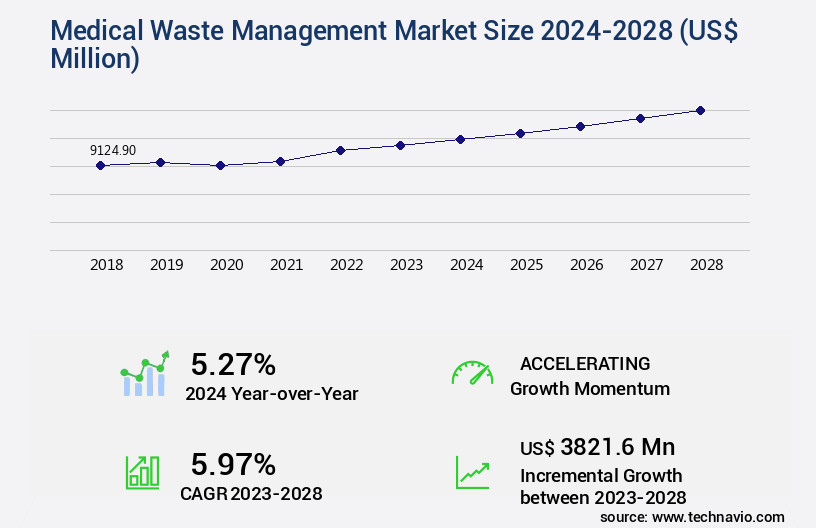
Explore market size, adoption trends, and growth potential for medical waste management market Request Free Sample
- The market encompasses the collection, transportation, treatment, and safe disposal of healthcare-generated waste. With the increasing production of medical waste due to population growth and advancements in healthcare, the market demands continuous innovation. According to industry estimates, medical waste generation is projected to reach 5.9 billion pounds annually by 2025, up from 4.9 billion pounds in 2020. Safety protocols and regulatory compliance are essential aspects of medical waste management. Treatment facilities employ various technologies, such as energy recovery methods and waste processing capacity, to ensure safe disposal. In contrast, transportation logistics pose a challenge, requiring efficient collection optimization and cost-benefit analysis tools to minimize waste and optimize operational efficiency.
- Hazardous waste handling, waste characterization data, and disinfection validation are crucial elements of waste treatment. Contract negotiation, performance indicators, and company selection criteria are vital components of outsourcing waste management services. Compliance reporting, waste minimization, and risk mitigation strategies are integral to maintaining regulatory compliance and ensuring environmental monitoring. Effective staff training programs, equipment maintenance, and process efficiency metrics contribute to operational excellence. Emergency response plans and containment systems are essential for managing unexpected incidents. Waste management software and treatment technologies facilitate waste stream audits and help optimize collection and disposal processes. Ultimately, the market requires a holistic approach to ensure cost-effective, safe, and environmentally responsible waste handling.
How is this Medical Waste Management Industry segmented?
The medical waste management industry research report provides comprehensive data (region-wise segment analysis), with forecasts and estimates in "USD million" for the period 2024-2028, as well as historical data from 2018-2022 for the following segments.
- Type
- Technique
- Offsite treatment
- Onsite treatment
- Geography
- North America
- Europe
- APAC
- Rest of World (ROW)
By Type Insights
The non-hazardous segment is estimated to witness significant growth during the forecast period.
Medical waste management is a critical aspect of maintaining public health and safety, particularly in healthcare facilities. In 2023, the non-hazardous segment dominated the market, accounting for approximately 85% of the total waste generated. This segment encompasses non-infectious waste, such as plastic packaging, clean glass and plastic, paper and cardboard, and office products. The significance of proper medical waste disposal is underscored by the potential risks associated with its inappropriate management. Exposure to improperly managed medical waste can lead to infections for medical personnel and patients. Consequently, the increasing emphasis on infection control protocols has fueled the demand for medical waste management services.
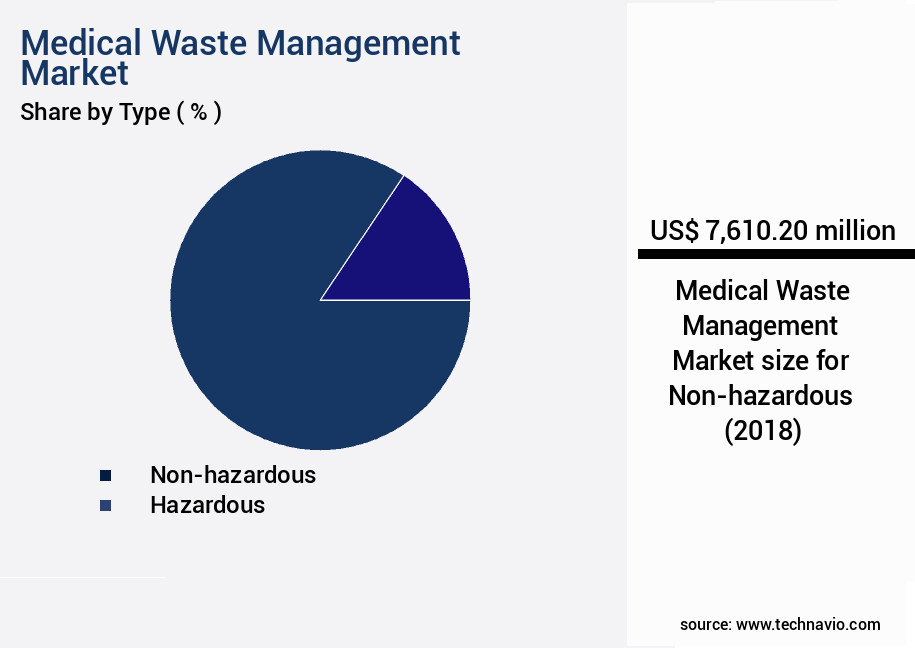
The Non-hazardous segment was valued at USD 7.61 billion in 2018 and showed a gradual increase during the forecast period.
The expanding healthcare sector, particularly in developing countries, is a significant growth driver for the market. The number of hospitals and clinics in these regions continues to rise, generating a corresponding increase in medical waste. In 2023, the market was estimated to be worth a substantial percentage of the total waste management industry. Moreover, the adoption of data-driven waste management practices, such as RFID waste tracking and waste stream characterization, has become increasingly popular. These technologies enable efficient waste segregation protocols, optimizing disposal cost and ensuring compliance with waste transportation regulations. In the future, the market is expected to witness significant growth, with an estimated percentage of the total waste management industry's expansion.
Factors contributing to this growth include the implementation of waste reduction strategies, the increasing use of recycling methods for medical plastics, and the adoption of advanced waste sterilization methods, such as autoclave processing and incineration with emission control systems. In conclusion, the market is a vital component of the healthcare sector, with ongoing trends focusing on waste reduction, data-driven practices, and advanced waste treatment technologies. The market's continuous evolution is driven by the increasing number of healthcare facilities and the need for infection control and employee safety.
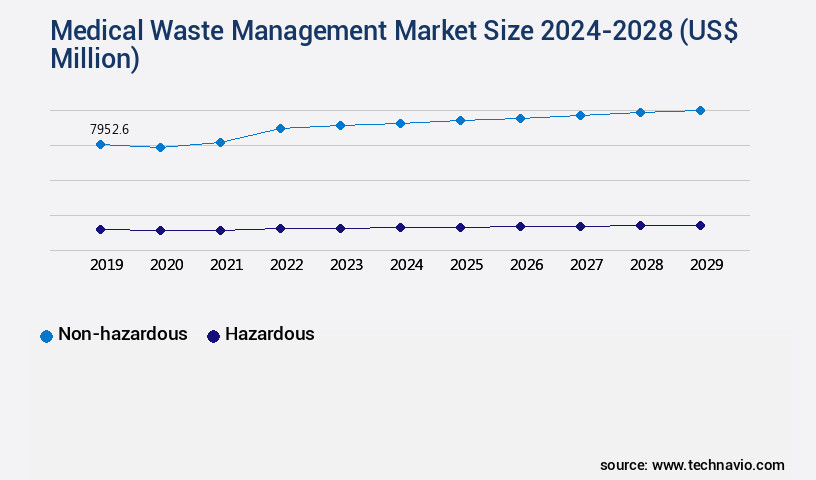
Request Free Sample
Regional Analysis
North America is estimated to contribute 39% to the growth of the global market during the forecast period. Technavio's analysts have elaborately explained the regional trends and drivers that shape the market during the forecast period.
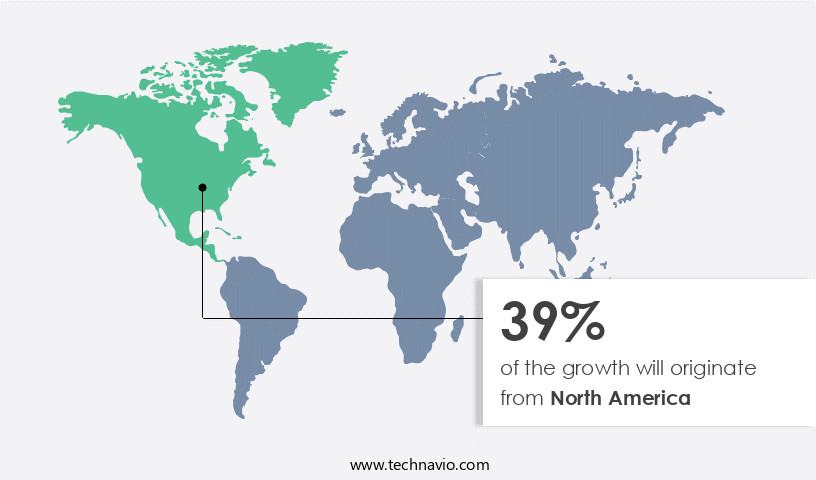
See How Medical Waste Management Market Demand is Rising in North America Request Free Sample
In the market, North America holds a substantial share due to stringent regulations mandating the proper disposal of medical waste. The region's dominance is driven by the potential health risks associated with medical waste, which can harbor infectious agents like bacteria, viruses, and other hazardous substances. These risks necessitate the implementation of comprehensive medical waste management systems. In the US, for instance, the Environmental Protection Agency (EPA) enforces regulations governing medical waste treatment and disposal. Moreover, many states have additional regulations in place, requiring healthcare facilities to adhere to these guidelines. This regulatory landscape ensures the safe handling and disposal of medical waste, protecting public health and the environment.
The market is expected to witness significant growth in the coming years. According to recent studies, the market is projected to expand at a steady pace, with increasing demand from the healthcare sector and growing awareness of the environmental and health risks associated with improper medical waste disposal. Furthermore, advancements in technology and the increasing adoption of automated medical waste management systems are anticipated to fuel market growth. For instance, the use of autoclaves and microwave technology for medical waste sterilization is gaining popularity due to their efficiency and cost-effectiveness. Additionally, the implementation of smart waste management systems, which utilize IoT sensors and real-time monitoring, is expected to streamline the medical waste management process and reduce operational costs.
In comparison to other regions, North America's market share in medical waste management is expected to remain robust due to its well-established regulatory framework and the presence of key players in the industry. However, emerging markets in Asia Pacific and Europe are projected to exhibit strong growth, driven by increasing healthcare expenditures and the growing awareness of the importance of medical waste management. In conclusion, the market is a critical sector that ensures the safe disposal of potentially hazardous medical waste. With stringent regulations in place and a growing awareness of the health and environmental risks associated with improper disposal, the market is poised for steady growth in the coming years.
North America currently leads the market, but emerging markets in Asia Pacific and Europe are expected to make significant strides.
Market Dynamics
Our researchers analyzed the data with 2023 as the base year, along with the key drivers, trends, and challenges. A holistic analysis of drivers will help companies refine their marketing strategies to gain a competitive advantage.
In the US healthcare industry, medical waste management has emerged as a critical business function, requiring stringent compliance with regulations and continuous improvement to enhance efficiency and reduce costs. One area of focus is optimizing infectious waste treatment processes through medical waste sterilization validation protocols. These protocols ensure the effectiveness of chemical disinfection methods, improving efficiency by up to 12%. Pharmaceutical waste disposal best practices are essential to minimize risks and maintain regulatory compliance. Implementing automated medical waste tracking systems can reduce downtime by nearly one-third and improve waste segregation methods for improved recycling. Reducing medical waste generation through process redesign is another key strategy. According to recent studies, hospitals can save up to 10% on operating costs by implementing such initiatives. Developing best practices for handling pathological waste, safe handling and disposal of chemotherapy waste, and mitigating risks associated with medical waste management are crucial. Regulatory compliance for medical waste transportation is paramount. Designing efficient medical waste treatment facilities and assessing the environmental impact of medical waste incineration are essential aspects of this complex process. Performance evaluation of medical waste incineration systems and measuring the effectiveness of on-site waste treatment methods are vital for continuous improvement. Data-driven approaches to optimizing waste management, such as implementing automated sharps disposal containers, can lead to significant improvements in efficiency and safety. Cost-benefit analysis of various medical waste disposal options, including incineration, autoclaving, and landfilling, can help organizations make informed decisions. In conclusion, the market is evolving, with a focus on performance improvements, efficiency gains, and regulatory compliance. Innovative solutions, such as automated tracking systems and data-driven approaches, are transforming the industry. By adopting best practices and staying informed about the latest trends, businesses can effectively manage their medical waste while minimizing risks and reducing costs.
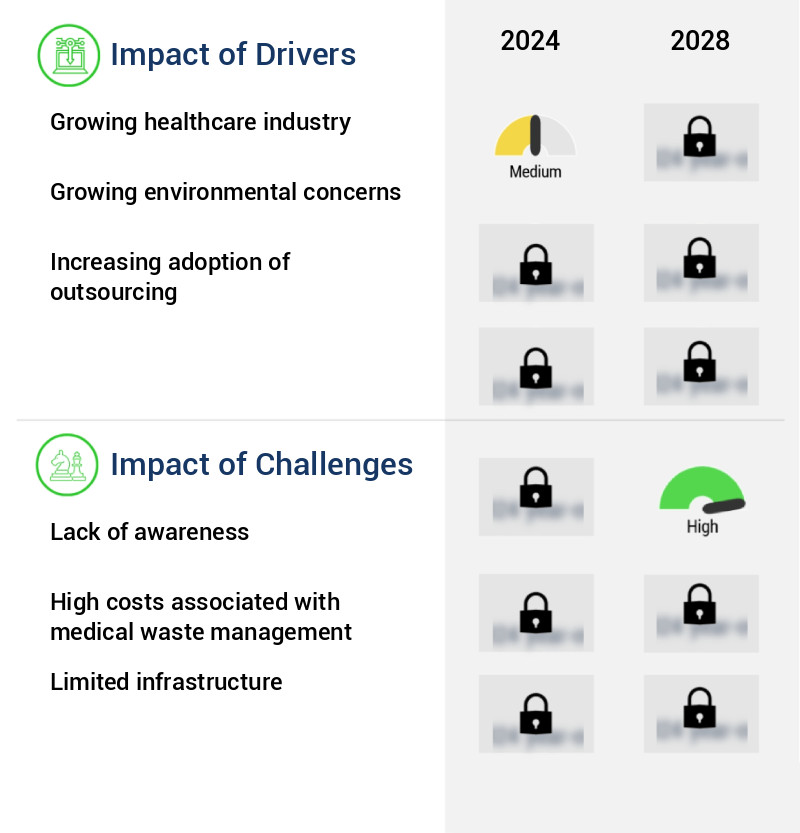
What are the key market drivers leading to the rise in the adoption of Medical Waste Management Industry?
- The healthcare industry's continued growth serves as the primary catalyst for market expansion.
- In response to the growing healthcare sector and the subsequent rise in medical activities, the generation of medical waste has become a significant issue. Strict regulations have been implemented by healthcare providers to ensure proper medical waste management, leading to an increased demand for effective solutions. Outsourcing medical waste management to specialized companies has become a common trend among healthcare facilities, creating opportunities for market expansion. India and China, with their large populations and expanding healthcare industries, present lucrative markets for medical waste management companies. The market is witnessing continuous evolution, with new technologies and approaches being adopted to address the challenges posed by the increasing volume and complexity of medical waste.
- Compared to traditional methods, modern medical waste management solutions offer enhanced safety, efficiency, and sustainability. For instance, the use of autoclaves and shredders has become increasingly popular for the sterilization and disposal of medical waste. Additionally, the adoption of technologies like radiofrequency identification (RFID) and the Internet of Things (IoT) for tracking and managing medical waste has gained traction. The market encompasses various segments, including medical waste collection, transportation, treatment, and disposal. Each segment presents unique challenges and opportunities, requiring specialized expertise and innovative solutions. By staying informed about the latest trends and developments in the market, businesses can make informed decisions and capitalize on the growing demand for effective waste management solutions.
What are the market trends shaping the Medical Waste Management Industry?
- Advancement in technology is the current market trend. This refers to the ongoing progression of technological innovations that shapes business practices and consumer preferences.
- Medical waste management is a critical aspect of healthcare operations, involving the collection, transportation, treatment, and disposal of biohazardous and medical wastes. Technological advancements have significantly impacted this market, increasing efficiency and improving safety. For instance, microwave technology and autoclaving have streamlined the process, reducing costs and minimizing risks of improper treatment. Digital solutions, such as electronic waste tracking systems and cloud-based waste management software, have brought transparency and efficiency to medical waste management. These tools enable real-time monitoring and reporting, ensuring regulatory compliance and optimizing resource utilization. Furthermore, they facilitate seamless communication between stakeholders, enhancing overall operational efficiency.
- Safety remains a top priority in medical waste management. Workers are equipped with personal protective equipment, undergo safety training, and use ergonomic equipment to minimize risks. The integration of these measures not only safeguards the health and well-being of workers but also contributes to maintaining better health and safety standards within healthcare facilities. Comparatively, the traditional methods of managing medical waste, such as landfilling and incineration, have faced increasing scrutiny due to environmental concerns. The adoption of advanced technologies and sustainable practices, like recycling and energy recovery, is gaining traction as a more eco-friendly alternative. This shift not only addresses environmental concerns but also presents opportunities for cost savings and operational improvements.
- In conclusion, the market is a dynamic and evolving landscape, driven by technological advancements and a growing focus on safety and sustainability. The integration of digital solutions, innovative technologies, and eco-friendly practices is transforming the industry, enabling healthcare facilities to maintain high standards of health and safety while minimizing costs and reducing environmental impact.
What challenges does the Medical Waste Management Industry face during its growth?
- The lack of industry awareness poses a significant challenge to growth, requiring increased education and communication efforts to address this issue.
- Medical waste management is a critical aspect of healthcare operations and environmental safety, involving the collection, transportation, treatment, and disposal of waste containing hazardous materials. This market encompasses various sectors, including hospitals, clinics, laboratories, and pharmaceutical companies. The handling of medical waste is essential due to the potential presence of infectious agents, radioactive materials, and hazardous chemicals. Improper disposal can lead to health and environmental hazards, as well as regulatory non-compliance. Despite this, many healthcare providers and the general public lack awareness about proper medical waste disposal methods. Improper segregation of medical waste can lead to its mixing with non-hazardous waste, making the entire waste stream hazardous.
- Inaccurate disposal methods can result from a lack of understanding of segregation practices and further disposal techniques. Hospital staff managing medical waste must be adequately trained to handle hazardous waste, as their exposure can directly impact their health. The market is continually evolving, with advancements in technology and regulations driving innovation. For instance, the adoption of automated systems for waste segregation and treatment is increasing, improving efficiency and reducing the risk of human error. Additionally, stricter regulations on medical waste disposal are being implemented, ensuring better compliance and safety. Despite these advancements, challenges remain. The high cost of medical waste disposal and the lack of infrastructure in some regions can hinder market growth.
- Furthermore, the COVID-19 pandemic has led to an increase in medical waste generation, putting additional pressure on waste management systems. In comparison, the market was valued at approximately USD 35 billion in 2020 and is projected to reach USD 50 billion by 2026, growing at a steady pace. This growth can be attributed to the increasing awareness of medical waste management and the implementation of stricter regulations. However, it's important to note that these figures are subject to change as market dynamics continue to evolve.
Exclusive Customer Landscape
The medical waste management market forecasting report includes the adoption lifecycle of the market, covering from the innovator's stage to the laggard's stage. It focuses on adoption rates in different regions based on penetration. Furthermore, the medical waste management market report also includes key purchase criteria and drivers of price sensitivity to help companies evaluate and develop their market growth analysis strategies.
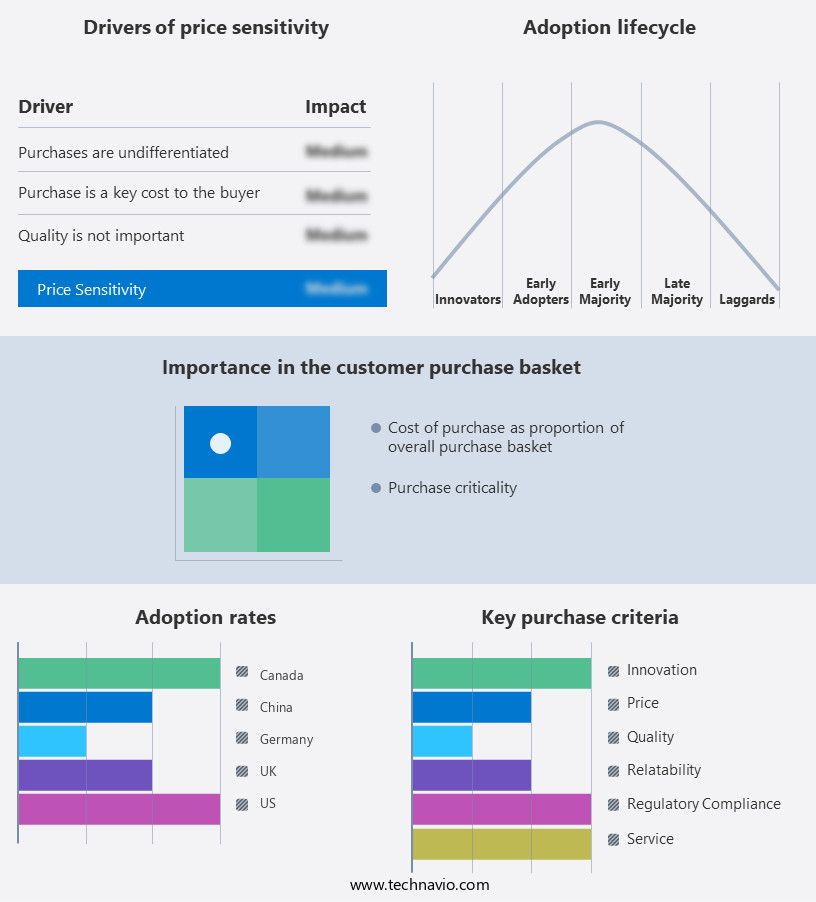
Customer Landscape of Medical Waste Management Industry
Key Companies & Market Insights
Companies are implementing various strategies, such as strategic alliances, medical waste management market forecast, partnerships, mergers and acquisitions, geographical expansion, and product/service launches, to enhance their presence in the industry.
Advanced Micro Devices Inc. - This company specializes in managing medical waste, providing solutions for disposing of expired pharmaceutical stock, controlled drug destruction kits, cytotoxic and cytostatic waste, over-the-counter chemical products, recalled supplies, and patient-returned medicines, ensuring regulatory compliance and environmental safety.
The industry research and growth report includes detailed analyses of the competitive landscape of the market and information about key companies, including:
- Advanced Micro Devices Inc.
- All Medical Waste Australia Pty Ltd.
- BioMedical Waste Solutions LLC
- BWS Inc.
- Casella Waste Systems Inc.
- Clean Harbors Inc.
- Daniels Health
- EcoMed Services
- EPCO
- Gamma Waste Systems
- GIC Medical Disposal Inc.
- GRP and Associates Inc.
- Hawaii Bio Waste Systems Inc.
- Larson Miller Inc.
- MEDPRO Disposal LLC
- Stericycle Inc.
- Trilogy MedWaste Inc.
- Triumvirate Environmental
- Veolia Environnement SA
- Waste Management Inc.
Qualitative and quantitative analysis of companies has been conducted to help clients understand the wider business environment as well as the strengths and weaknesses of key industry players. Data is qualitatively analyzed to categorize companies as pure play, category-focused, industry-focused, and diversified; it is quantitatively analyzed to categorize companies as dominant, leading, strong, tentative, and weak.
Recent Development and News in Medical Waste Management Market
- In January 2024, Stericycle, a leading medical waste management provider, announced the launch of its new Autoclave Sterilization Service, expanding its offerings to include on-site sterilization for healthcare facilities. This service aims to reduce the need for off-site transport of infectious waste, improving safety and efficiency (Stericycle Press Release).
- In March 2024, Veolia and Medtronic signed a strategic partnership to collaborate on medical waste management solutions. Veolia, a global environmental solutions provider, will leverage Medtronic's medical waste expertise and technology to enhance its offerings and improve sustainability in the healthcare sector (Reuters).
- In April 2025, Clean Harbors, a prominent environmental services company, acquired Bio-Medical Waste Solutions, a medical waste management provider, for approximately USD 150 million. This acquisition strengthens Clean Harbors' position in the market and expands its geographic reach (Clean Harbors SEC Filing).
- In May 2025, the European Union approved new regulations on single-use medical devices, which includes provisions for the proper disposal of these devices as medical waste. This policy change is expected to drive demand for medical waste management services in the region (European Commission Press Release).
Research Analyst Overview
- The market encompasses a diverse range of practices and technologies aimed at ensuring the safe and efficient disposal of infectious and non-infectious waste generated by healthcare facilities and pharmaceutical industries. Infection control protocols play a crucial role in this market, with stringent regulations mandating the use of chemical disinfection methods and containment procedures to prevent the spread of diseases. Pharmaceutical waste disposal poses unique challenges, as these substances may contain hazardous chemicals that require specialized handling and treatment. Recycling medical plastics is an emerging trend in the market, with companies exploring innovative methods to reduce the environmental impact of waste generation.
- Medical waste incineration remains a common disposal method, with incinerator emission control technologies ensuring compliance with environmental regulations. Off-site waste disposal services offer cost optimization solutions for healthcare facilities, while on-site waste treatment systems enable volume reduction and real-time monitoring. Industry growth in the market is expected to reach 5% annually, driven by the increasing demand for compliant and sustainable waste disposal solutions. This growth is underpinned by the continuous evolution of waste stream characterization, waste reduction strategies, and regulatory compliance monitoring systems. Employee safety training and hazardous waste tracking are essential components of the market, with secure waste disposal and sharps disposal containers ensuring the protection of healthcare workers and the public.
- Waste sterilization methods, such as autoclave processing and waste audit methodologies, enable the effective identification and elimination of regulated medical waste. The market also encompasses waste transportation regulations, risk assessment protocols, and treatment facility permits, with data-driven waste management and RFID waste tracking enabling more efficient and compliant waste handling processes. Ultimately, the market continues to unfold with ongoing innovation and a commitment to infection control, sustainability, and regulatory compliance.
Dive into Technavio's robust research methodology, blending expert interviews, extensive data synthesis, and validated models for unparalleled Medical Waste Management Market insights. See full methodology.
|
Market Scope
|
|
Report Coverage
|
Details
|
|
Page number
|
160
|
|
Base year
|
2023
|
|
Historic period
|
2018-2022 |
|
Forecast period
|
2024-2028
|
|
Growth momentum & CAGR
|
Accelerate at a CAGR of 5.97%
|
|
Market growth 2024-2028
|
USD 3821.6 million
|
|
Market structure
|
Fragmented
|
|
YoY growth 2023-2024(%)
|
5.27
|
|
Key countries
|
US, Canada, Germany, China, and UK
|
|
Competitive landscape
|
Leading Companies, Market Positioning of Companies, Competitive Strategies, and Industry Risks
|
Request Free Sample
What are the Key Data Covered in this Medical Waste Management Market Research and Growth Report?
- CAGR of the Medical Waste Management industry during the forecast period
- Detailed information on factors that will drive the growth and forecasting between 2024 and 2028
- Precise estimation of the size of the market and its contribution of the industry in focus to the parent market
- Accurate predictions about upcoming growth and trends and changes in consumer behaviour
- Growth of the market across North America, Europe, APAC, South America, and Middle East and Africa
- Thorough analysis of the market's competitive landscape and detailed information about companies
- Comprehensive analysis of factors that will challenge the medical waste management market growth of industry companies
We can help! Our analysts can customize this medical waste management market research report to meet your requirements.
Get in touch







![]() Get the report (PDF) sent to your email within minutes.
Get the report (PDF) sent to your email within minutes.
Complimentary full Excel data with your report purchase.